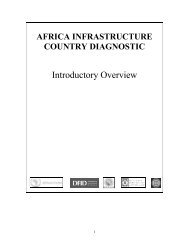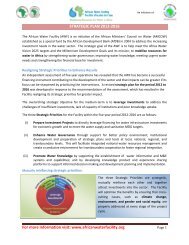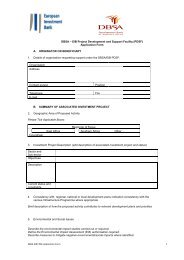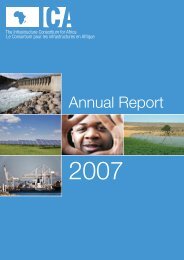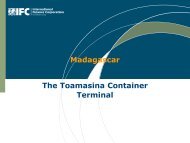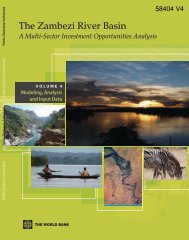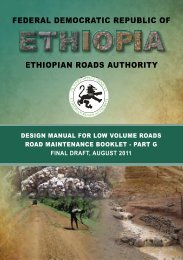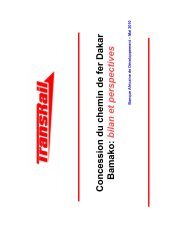Design-Manual-for-Low-Volume-Roads-Part-A
Design-Manual-for-Low-Volume-Roads-Part-A
Design-Manual-for-Low-Volume-Roads-Part-A
Create successful ePaper yourself
Turn your PDF publications into a flip-book with our unique Google optimized e-Paper software.
A - Chapter 2 - 10<br />
2.<br />
STRUCTURE AND LAYOUT<br />
The low volume road manual has been drafted with a view to it being fully adaptable <strong>for</strong> different clients.<br />
The <strong>Manual</strong> has application <strong>for</strong> roads at a federal level and administered by the Ethiopian <strong>Roads</strong> Authority,<br />
regional level <strong>for</strong> roads administered by the Regional and Rural <strong>Roads</strong> Authorities and district level <strong>for</strong><br />
roads administered by district (Wereda /Kebele) administrations or communities. The document can cater<br />
<strong>for</strong> interventions that deal with individual critical areas on a road link (spot improvements) through to<br />
providing total rural road link designs. In this latter case, this could comprise different design options<br />
along the total length.<br />
The <strong>Manual</strong> is divided into five parts:<br />
• <strong>Part</strong> A provides an overview of the <strong>Manual</strong>, its application, context, use and introduces the<br />
philosophy of low volume road design.<br />
• <strong>Part</strong> B sets out typical design controls that should be considered during the design process and<br />
the national design standards <strong>for</strong> low volume roads in Ethiopia. These are mandatory standards<br />
that must be adhered to by the engineer. Departures from these standards are only permitted in<br />
exceptional circumstances and with the prior approval of the relevant authorities.<br />
• <strong>Part</strong> C describes how complementary interventions and activities can be introduced into the road<br />
works contract and how these can add value and impact to the project <strong>for</strong> the client and beneficiary<br />
communities, and users.<br />
• <strong>Part</strong> D provides the engineering details and guidance on the application of the national standards<br />
<strong>for</strong> the design of low volume roads given in <strong>Part</strong> B.<br />
• <strong>Part</strong> E provides the engineering details and guidance on the design of low level structures and<br />
water crossings <strong>for</strong> low volume roads.<br />
The structure of the <strong>Manual</strong> is shown in Figure A.2.1.<br />
The low volume road manual is comprehensive, in that it deals with the design standards and technicalities<br />
of all types of road (paved and unpaved), low level water crossing structures and socio-environmental<br />
aspects. The <strong>Manual</strong> deals with design standards <strong>for</strong> road geometry, earthworks, drainage, pavement<br />
structures and surfacing, with relevant approaches to route selection, site investigation, materials selection,<br />
testing and treatment, and the design of low level water crossings and structures <strong>for</strong> low volume roads.<br />
The structure of the <strong>Manual</strong> is such that it allows client authorities (Federal, Regional and Wereda) to<br />
extract and use those parts of the <strong>Manual</strong> most appropriate to their individual set of circumstances. The<br />
complete document can be downsized to capture specific and appropriate aspects.<br />
In terms of “road type”, Wereda Administrations, Kebele committees, community organisations or<br />
cooperatives would generally be concerned with the design of low volume unpaved, earth and gravel<br />
roads. Regional Road Authorities and the ERA would be concerned with larger gravel roads and bituminous<br />
sealed roads. <strong>Part</strong> D of the <strong>Manual</strong> captures all of the design elements, approaches and aspects <strong>for</strong> each<br />
of these types of roads. The <strong>Manual</strong> deals with each of these road types and the national standards <strong>for</strong><br />
particular road types are set out and explained in <strong>Part</strong> B. <strong>Part</strong> B can be used by the engineer or others<br />
who simply needs to look-up the values of the key parameters.<br />
All authorities should find application <strong>for</strong> alternative surfacing technologies and spot improvement<br />
approaches (<strong>Part</strong> D) and <strong>for</strong> utilisation of low level water crossings (<strong>Part</strong> E). All authorities should also be<br />
interested to find application <strong>for</strong> complementary interventions and activities (<strong>Part</strong> C).<br />
A clear understanding of the end users and their requirement <strong>for</strong> the <strong>Manual</strong> document is essential. The<br />
low volume road manual caters <strong>for</strong> a range of road type, from basic earth tracks to bituminous sealed<br />
roads. It is unlikely that one institution will cater <strong>for</strong> all standards of road and more likely that the document<br />
will have application across a number of different authorities, agencies and ministries. Bituminised and<br />
major gravel roads in Ethiopia are constructed and maintained by the Federal and Regional <strong>Roads</strong><br />
Authorities. The Districts (Wereda) and sub-districts (Kebele) have substantial networks of unpaved<br />
PART A: DESIGN STANDARD APPROACHES




